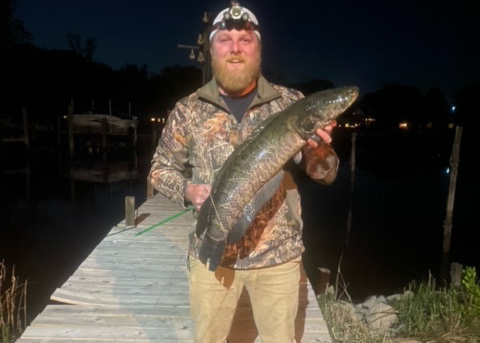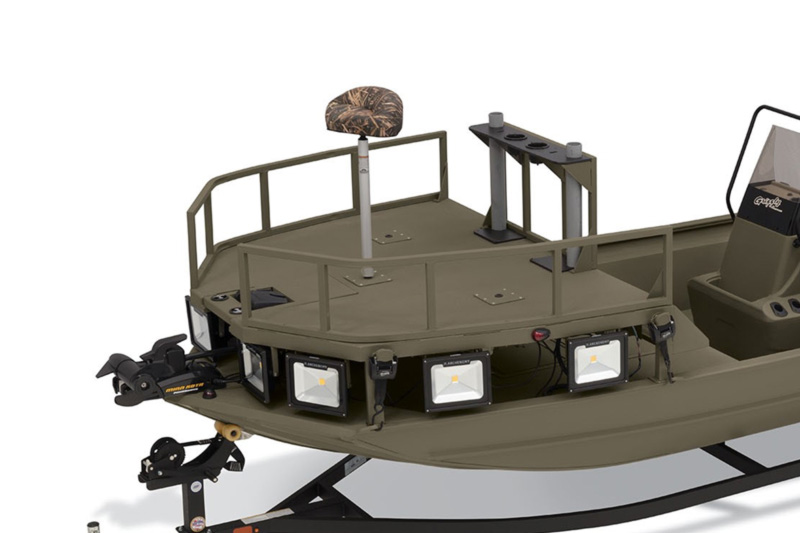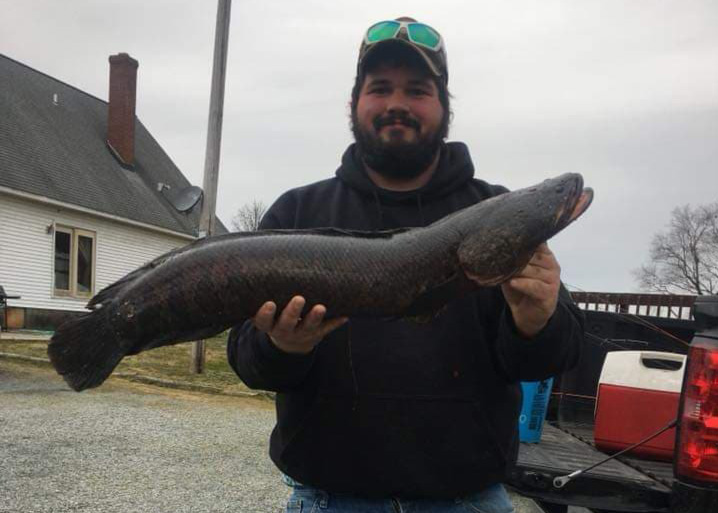Although many different species of snakehead exist, the Northern snakehead are the ones to look out for when fishing in Chesapeake country—and as you surely know, fishing for snakeheads has become incredibly popular. Snakeheads are very unique from other freshwater fish, as they are able to live out of water for extended periods of time. They are also an invasive species to our local waterways, so it’s important (and mandatory throughout the region) to kill any kept in your possession. While these fish are most commonly caught using a hook and line setup, hunting for snakeheads with a bow and arrow has become a popular pastime for recreational fishermen. Bowfishing offers those a thrill unlike any other fishing technique out there. If you end up skewering some snakeheads, they are great eating, too. When cooked snakehead offers a firm, white, and flaky texture meat that works well in a variety of recipes.

Snakehead Identification
The Northern snakehead, also referred to as mudfish, belongs to the Channidae family. Snakeheads will often mature into massive fish, reaching lengths upwards of 33 inches. These fish are best recognized by the dark, irregular color blotches found along their sides. Also, they are long and slender fish with truncated tails and a snake-shaped head — hence the name.
Snakehead State Regulations
Currently, Delaware holds no minimum size or creel limits for Northern snakehead, and anglers can fish for them there year-round. In Maryland, there are also no regulations on the size and creel limits of these fish, and the season is open year-round. It is illegal, however, to possess live snakehead fish so they must be either released or killed on-site. Finally, Virginia holds the exact same regulations as Maryland does for Northern snakehead. Here are links to each state’s regulations:
Snakehead State Records
In Maryland, the state record for northern snakehead was set by Andrew Fox. In May 2018, he caught a 19-pound 14-ounce fish from Mattawoman Creek. See our article titled News Flash: Record Snakehead and Flathead Catfish, and Crab Countdown for Fox’s complete story. Virginia’s state bowfishing record for snakehead was set by Eric Beebe in April 2020, where he shot a 16-pound 14-ounce fish. Delaware’s bowfishing record-holder for snakehead is Tristan Friel. Friel caught his record-setting 12-pound 10-ounce fish back in July of 2020.
Best Bowfishing Tackle for Snakeheads
New information on bowfishing for these fish is always popping up, so we phoned expert snakehead bowfishing sharpie Captain Wayne Waters, Jr. to gain his perspective on the matter. The equipment he recommends to those wishing to bowfish for snakehead for the very first time includes:
- A recurve bow, equipped with a lightweight hand reel
- Bowfishing-rated braided fishing line — use caution, as this type can be very sharp!
- Fiberglass arrows with barbed or pronged arrowheads
- For daytime bowfishing, use polarized sunglasses
- For night time bowfishing, attach high-pressure sodium lights to your boat
Best Boats for Bowfishing
For those wanting to bowfish, it’s important to use boats with shallow water capabilities, such as aluminum fishing boats. For this, Wayne recommends something like the Tracker 1872 flat-bottom fishing boat. Used for shooting bigger areas like the Potomac River, this vessel can hold up to four shooters plus a driver up front. For smaller waterways, he suggests using a boat like the G3 1560, which can generally fit three people comfortably and can make it into more restricted waterways. And remember those lights captain Wayne mentioned; rig as many as you can along the boat’s bow and gunwales to cover as much water as possible, and ensure that you have the battery capacity needed to illuminate the water for as long as you plan on bowfishing. While this can be done during the day, hunting snakes under the cover of darkness using artificial lights is much more effective.

Popular Techniques for Snakehead Bowfishing
For beginner fishermen going on their first bowfishing trip for snakehead, it is important to know the depth of water that you’ll be shooting in. In order to ensure adequate visibility for a clear shot, look for areas where the water is no more than three to four feet deep. In tidal waters, bowfishing during low tide levels is recommended. A recent storm can also stir up sediments in the water, making it more difficult to spot snakeheads. Light refraction from the water can pose a real problem when zeroing in on a snakehead, so a good rule of thumb is to aim three inches lower for every foot of depth the fish is submerged.
Regardless of whether you bowfish from a boat or by the shore, getting your arrow stuck in the mud or some dense vegetation is an inevitable reality. If an arrow gets stuck, find its location and carefully retrieve it. Or, if fishing from a boat, carefully tie the fishing line around a cleat and slowly dig it out with the boat. Keep extra arrows on hand in case you lose one in the mud or it breaks.

When shooting snakehead, most bowfishing experts recommend a draw weight of roughly 35 pounds. This shooting weight increases the likelihood of puncturing the fish without letting your arrow find its way into the bottom. Also, try to hit the center body of the fish to ensure that it stays attached to the arrow when reeling it in.
Best Places to Go Bowfishing for Snakeheads
In the DelMarVa region, Northern snakeheads are commonly spotted in stagnant and shallow waters, such as ponds or swamps. They also like to hide in rivers that contain mud substrates and aquatic vegetation. Top area hotspots include creeks off the Rappahannock and Potomac Rivers, the Susquehanna Flats area, and the Blackwater complex. Although the Blackwater does have perhaps the biggest snakehead population, in many areas it’s also harder to spot the fish because of the black coloration of the bottom.
As most experienced bow fishermen could tell you, picking up a new bow and hitting every snakehead you see is no easy task. With enough practice and patience, however, you will be successfully shooting snakeheads before you know it.
-By Cameron White